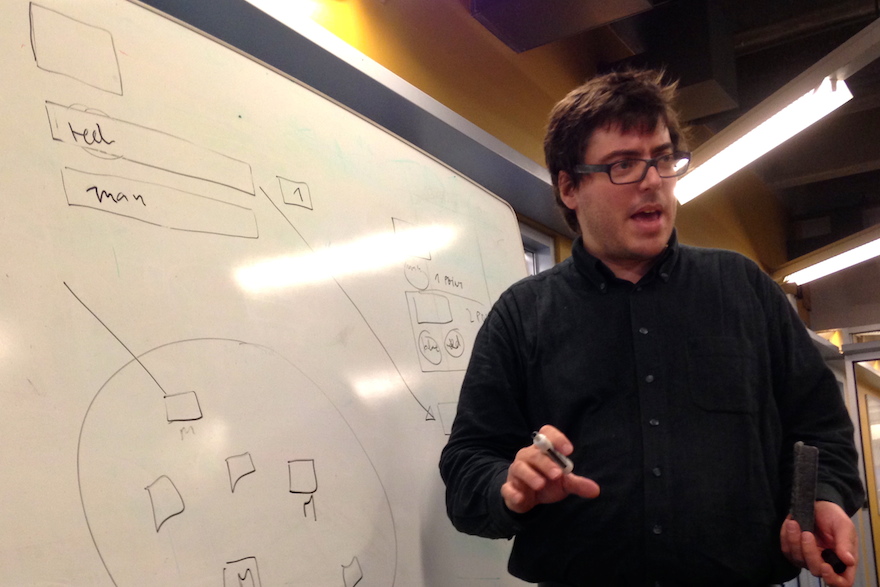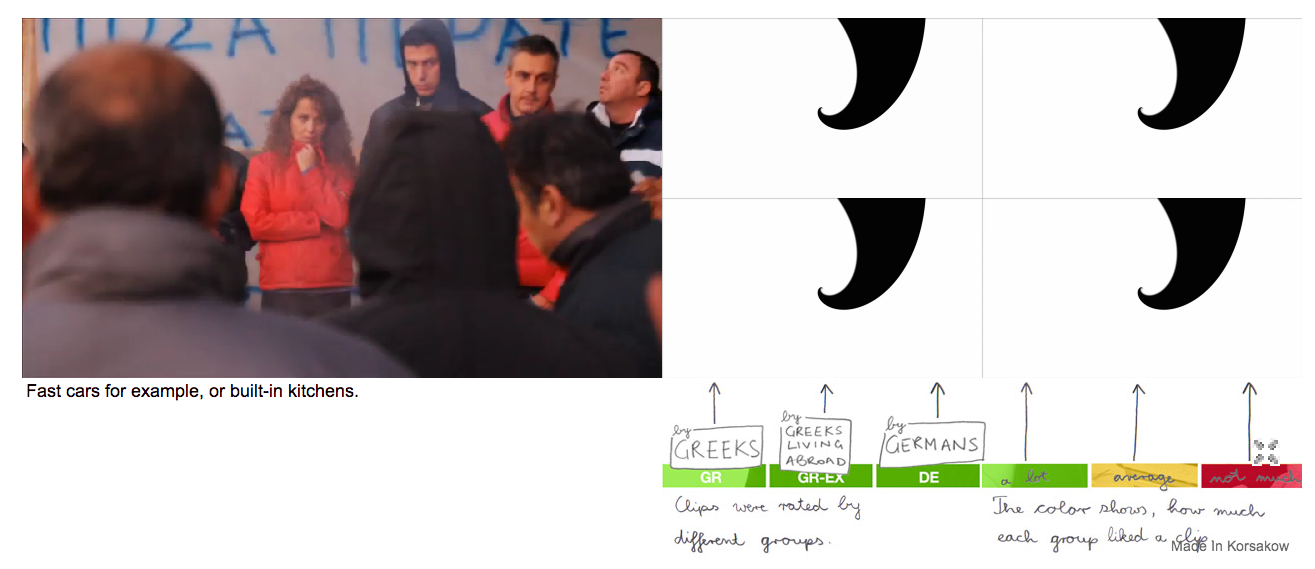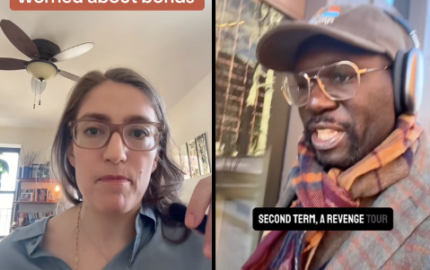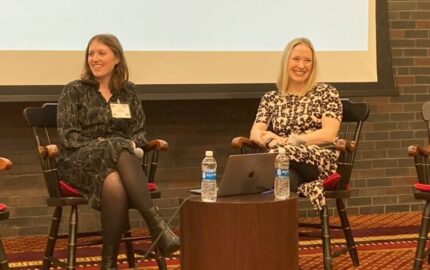Thalhofer, a documentary filmmaker based in Berlin, had to build his own software in order to deliver the kind of stories he wanted to tell. Now he offers that software for free online for small projects (larger projects require licensing), and he travels the world giving workshops on how to use it. Those workshops are less about the software, though, and more about his philosophy of storytelling, one that is decidedly nonlinear.
To many journalists, a “nonlinear story” is a contradiction in terms. And it probably is. But Thalhofer argues that breaking away from the then-this, then-that, then-this form of traditional narrative will lead to more accurate recountings of people and their experiences. I Skyped with Thalhofer recently, not long after attending his workshop at M.I.T.:
Storyboard: You’re a documentary filmmaker making nonlinear films and encouraging others to move away from narrative. What do you have against telling stories with clear beginnings, middles, and endings? What’s not to like about the narrative story?

Florian Thalhofer: I’m not against the linear story — that is fine. But there is another way to look at things, and I can see the boundaries of linear storytelling. We are basically able to see the things that we can put into linear stories, but we don’t have a good talent for seeing things that we cannot put into a linear format, but they are still there. The example I use is you ride on a subway and you observe something. It might be a feeling or something that touches you in some way, but it’s not a story. It’s not something you can easily tell when you go home to your wife or your girlfriend or your boyfriend or whatever. It’s a bit frustrating to tell an observation that doesn’t have an end and a moral to it. But I find that those are really the things that take me further.
You’ve created a kind of video storytelling that is possible only with computers. You developed a software platform called Korsakow that lets filmmakers enter a series of short video clips and then set up a system of rules and tags that let viewers choose different paths through the material. How is that different than the kind of choose-your-own-adventure books many of us read as kids?
In a choose-your-own-adventure story it’s all about the author predefining possible paths for the viewer. In Korsakow, it’s more that the author creates the rules for how the paths then happen. You could say it’s a research tool. It’s a tool that allows you to create all kinds of useful possible connections. The goal might be to find interesting patterns, but not necessarily to tell a cool story.
So in your system, short clips from a documentary become data that can get organized in different ways. Like a research project that lets people combine them and see them in different orders. Is that right?
Yes. Because it’s a tool, you can design all kinds of structures. The beauty of Korsakow is when you create an open narrative.
I think it helps to talk about a specific example of what you’re arguing for. Your latest work is a 90-minute interactive film called Money and the Greeks, which you made in Korsakow, about the financial crisis in Greece. Can you tell us briefly how that film works, and what it’s like as a viewer?
As a viewer you see video clips and then choose the next clip (from a set of choices.) It starts with an introduction to the topic, and then you hear people talking about their experiences. Then the system finds other people talking about the same topic from different angles, and you go from one topic to the other. It’s not random; it’s organized by topics, and you go from one topic to another, so that you get an idea of what people think at that time about the crisis. I traveled through Greece together with my wife — she’s Greek — and we talked to all kinds of people. That’s how the project started. We include different voices: people living in Greece and politicians and experts. And there’s also me describing what happened on my travels and my thoughts. I’m not an expert on the economy, and I’m not an expert on Greece, so I’m just an open-minded person. It’s more a documentation really. I don’t want to say, “This is how things work.” It’s more to show interesting observations and document them.

There is my voice in there as an opinion, so it’s not objective. But I don’t say, “This is how things work.” That’s what drove me a bit crazy about this topic — about what you heard on the radio, what you read in the newspapers. There were a lot of people who said, “This is the problem. This is how to solve it.” And it changed over time, but it was basically all wrong. It was simplified to the point that it basically didn’t make sense. It created a lot of hostility between people in Germany and people in Greece, for example, because they all found themselves misunderstood. But no one tried to understand the other point of view. It’s not that they were all wrong. They basically were all right. They all had a viewpoint.
Could you point to a moment in that film that highlights, at least for you, the power of the format?
A highlight for me is when there is a taxi driver in the film in Athens. He’s quite annoying. The editor, my friend who is Greek, he said, “I would have never talked to the guy. Because, you know, he’s a taxi driver and he has all these opinions.” But because we talked to him for such a long time, he opened up, and at some point he said quite reflective stuff that was contradicting himself, and it was really interesting. And then later on we did an interview with a politician in Germany who is an expert on economics, and she said pretty much the same thing the guy said. It was cool because in the interactive film it comes together, because Korsakow finds the connections based on the keywords I put in. When I make this film I don’t have a story I want to tell and an argument I want to make. I have particular themes.
There’s this truism that the human animal is just a storytelling being. One quote I read from Margaret Atwood has that “We must narrate or die.” Are you disputing that tendency?
I like the term truism. As with all things that are said in the extreme, it doesn’t make sense. I’m not dead, am I? If I want to convince you about what I think about whatever, then the best tool to convince you is to put it into a great story with a beginning, middle, and end so you can learn something from it. So go for that. If you want to openly think about a subject, it’s not helpful to put even the tiny bits into these small stories that take extreme standpoints to make clear what the problem is. Then we get on a track that is basically not so interesting, and we are basically just pissed off at the guy with the other opinion.
There was something you said at MIT that struck me, which is you argued that we’ve gotten to the point where we tell so many stories in our culture — with reality TV and all that kind of stuff — that people are now trying to live their lives differently because they want to be in a story. Could you talk about that?
The format is everywhere, this linear storytelling. There’s a beginning, middle, and end, and this is life. Then people want to — I’m not sure whether they’re aware of that — but they want to put their life into a Hollywood story. Getting married, having kids, and so on. But life is not a Hollywood film, and so many people are unhappy because of that. Basically if you tell the story of Obama or someone you will twist things to tell the story. This is the job of a filmmaker. A life in itself is so beautiful, and things go in one direction and then another direction. We are socialized in a very, very linear format with film. I think it’s the dominant structure that we have to deal with. So people at the moment enjoy very linear things. And this might change over time. I think it is a very slow process for people to get their head around. I think it takes at least a generation. We need to rewire the brain. It’s like, I once had a friend who was colorblind, and he was collecting green pencils because for him they looked all different. He had a deeper understanding of the green but no understanding of the other colors. For me, linear storytelling feels like a colorblindness. We can see all colors of green, but not other colors.
What drew you to this kind of storytelling?
 Basically I had no idea what I was doing. I didn’t know about storytelling. I was in an arts school, and we were thinking of how can we structure on a computer. I loved writing texts. At that time it was not defined how you would put that on the computer, so I developed my own format. The idea was: How does it make sense to structure narrative bits and pieces on a computer? It doesn’t make sense to put it in a linear form, one after the other. This makes sense when you have a film reel. But on a computer you can put it in different ways.
Basically I had no idea what I was doing. I didn’t know about storytelling. I was in an arts school, and we were thinking of how can we structure on a computer. I loved writing texts. At that time it was not defined how you would put that on the computer, so I developed my own format. The idea was: How does it make sense to structure narrative bits and pieces on a computer? It doesn’t make sense to put it in a linear form, one after the other. This makes sense when you have a film reel. But on a computer you can put it in different ways.When we first met, you said you were surprised that a journalist was interested in your ideas because you said usually journalists are not so keen on your ideas. What do you mean?
Many journalists have the view, I think, that they go to a place and find out how things work, and then they are the expert and tell it to the audience. As if they knew what they are talking about. (Laughs.) Journalists think that they can do a better job than experts or people who live in that place for many years. They say, “I can do a better job because I know a lot of tools of storytelling,” and they put it in that form, and they think that in the end they know better, and I think that’s funny.
I hear you, but as somebody doing narrative journalism myself I think the world is so full of unstructured bits that there is a value in making meaning through stories. It seems the downside of your approach is you can lose even the thread of what you’re talking about; it can feel like raw footage that never goes anywhere.
I agree with the observation. Maybe it’s not a film for entertaining people. Maybe it’s a documentation — a portrait of a time we have — and I hope it’s interesting to people in the future. This is not raw footage, by the way. [For Money and the Greeks] we had 40 hours of material and there were various stages of how we got from raw footage to the end. So we edited it down, so it is a concentrate of information of things and of thoughts. In the end, I tried to have really concrete things in there.
Jeff Young is a current Nieman Fellow at Harvard. He is the technology editor for The Chronicle of Higher Education, and has taught multimedia journalism at the University of Maryland at College Park. He is the author of the ebook Beyond the MOOC Hype: A Guide to Higher Education's High-Tech Disruption. Follow him at @jryoung.


